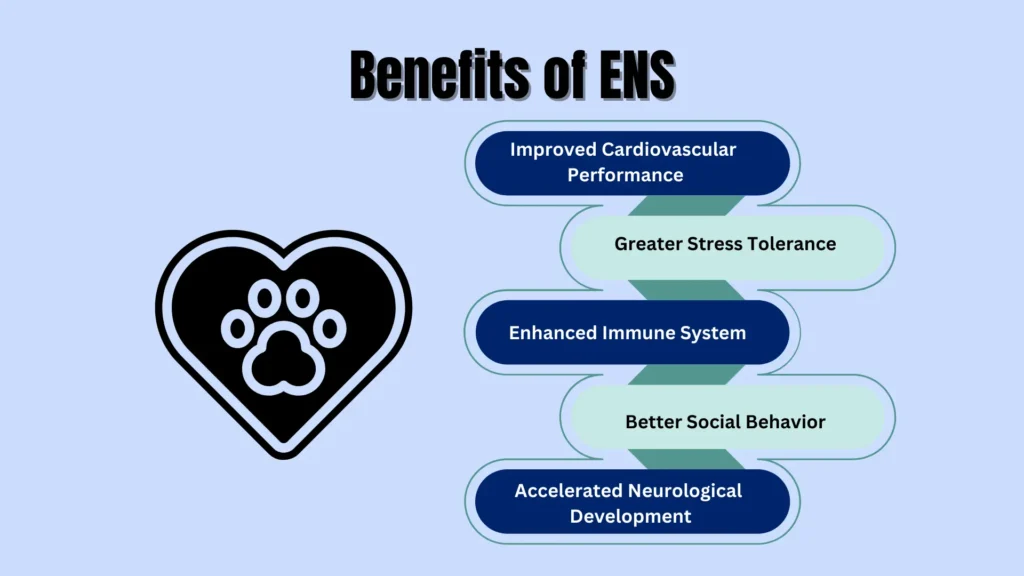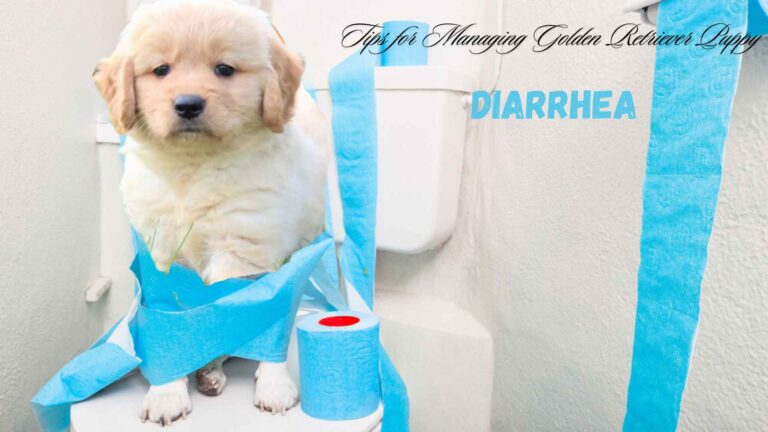Day 3 Starts Early Neurological Stimulation (ENS)For Puppies:
ENS for puppies; Early Neurological Stimulation is a technique that many breeders and pet owners are adopting to enhance the development and well-being of their dogs. This process involves a series of gentle handling exercises that are performed on puppies from their third to the sixteenth day of life. The goal is to stimulate the neurological system at a time when the puppy’s brain is rapidly developing, which can lead to improved cardiovascular performance, stronger heartbeats, better tolerance to stress, and greater disease resistance.
The problem many dog owners face is that their pets often struggle with stress and anxiety as they grow older. These issues can manifest in various ways, including poor behaviour, health problems, and difficulty in training. Traditional methods of raising puppies sometimes fail to address these potential health problems early enough. However, by incorporating ENS for puppies into their early development, owners can help mitigate these issues. This early intervention lays the foundation for a more resilient and well-adjusted adult dog.
The solution lies in the structured approach of ENS for puppies, which involves specific handling techniques such as tickling between the toes, holding the puppy upright, and placing it on a cold surface. These simple exercises, when performed correctly, can have profound benefits. Owners who practice ENS often observe that their puppies grow up to be more adaptable, healthier, and better equipped to handle the challenges of their environment. By investing a small amount of time in ENS, the long-term benefits for both the puppy and the owner can be significant.
Here are the comprehensive details along with the ENS benefits that you need to know. So, pay heed and see how ENS is effective for your fur babies. Let’s start!
Why Is The Period Between The Third And Sixteenth Day Critical For ENS?
If you are a new pet owner, it’s important to know that the period between the third and sixteenth day of a puppy’s life is critical for Early Neurological Stimulation (ENS) because this is when their nervous system is developing rapidly.
During this brief window, their brains are especially receptive to mild stressors, which can lead to significant long-term benefits. These gentle handling exercises help to enhance their cardiovascular function, strengthen their ability to handle stress and boost their overall health and resilience, setting the foundation for a well-adjusted and robust adult dog.
5 Specific Handling Techniques Involved In ENS For Puppies

Bearing in mind the crucial third and sixteenth day period, Early Neurological Stimulation (ENS) for puppies involves a series of specific handling techniques designed to stimulate their neurological development.
Here are five detailed techniques used in ENS for puppies:
Tactile Stimulation
Tactile stimulation involves gently tickling the puppy between its toes using a cotton swab or similar soft object. This exercise lasts for about 3 to 5 seconds. The purpose of this technique is to stimulate the puppy’s nervous system through touch, which helps to develop stronger motor skills and improves their response to tactile stimuli as they grow.
Head Held Erect
In this exercise, the puppy is held in a vertical position with its head directly above its tail. This position should be maintained for about 3 to 5 seconds. Holding the puppy upright helps to enhance its balance and coordination. It also stimulates the vestibular system, which is crucial for maintaining equilibrium and spatial orientation.
Head Pointed Down
This technique involves holding the puppy firmly in both hands with its head pointing downward and its tail pointing upward. Like the head held in an erect position, this exercise is also performed for 3 to 5 seconds. The head pointed down position helps to stimulate the puppy’s vestibular and nervous systems, encouraging better overall neurological development.
Supine Position
In the supine position, the puppy is held on its back with its head supported and its legs pointing upwards. This position should be held for about 3 to 5 seconds. This technique can initially cause some discomfort or resistance from the puppy, but it helps to develop their ability to cope with stress and unfamiliar situations, fostering greater adaptability.
Thermal Stimulation
Thermal stimulation involves placing the puppy on a cool, damp towel for about 3 to 5 seconds. This exercise exposes the puppy to a mild thermal stressor, which encourages the development of its body’s ability to regulate temperature. This technique helps to build resilience and enhances the puppy’s ability to handle varying environmental conditions.
Benefits of ENS You Need To Know

Now that you have an idea about various specific handling techniques involved in ENS for puppies, it’s important to understand the significant benefits this early stimulation can provide. Here are five key benefits of ENS that you need to know:
Improved Cardiovascular Performance
ENS techniques, such as tactile stimulation and different positional exercises, help enhance a puppy’s cardiovascular system. Puppies that undergo ENS often develop stronger heartbeats and better blood circulation. This improvement in cardiovascular performance can lead to a healthier heart and better overall physical endurance as the puppy grows.
Greater Stress Tolerance
One of the primary benefits of ENS is its ability to increase a puppy’s tolerance to stress. By exposing puppies to mild stressors during a critical developmental period, ENS helps them learn to cope with challenging situations more effectively. This leads to adult dogs that are less anxious and more resilient in the face of new or stressful environments.
Enhanced Immune System
ENS has been shown to boost a puppy’s immune system, making them more resistant to diseases and infections. The early stimulation encourages the development of a robust immune response, which can contribute to fewer health issues and a longer, healthier life for the dog.
Better Social Behavior
Puppies that undergo ENS tend to display better social behaviours. The early handling and mild stressors help them become more adaptable and less fearful. This leads to dogs that are more confident and well-adjusted when interacting with other animals and humans, making them easier to train and better companions.
Accelerated Neurological Development
ENS stimulates the puppy’s nervous system at a crucial stage of development, leading to accelerated neurological growth. This results in enhanced brain function and improved cognitive abilities. Puppies that receive ENS often show better problem-solving skills, quicker learning, and more advanced mental capabilities compared to those that do not undergo ENS.
3 Common Misconceptions About ENS For Puppies

You might have heard about Early Neurological Stimulation (ENS) for puppies and its various benefits, but there are also some common misconceptions that can lead to misunderstandings about the process.
Here are three common misconceptions about ENS for puppies:
ENS is the Same as Socialization
Many people mistakenly believe that ENS and socialization are the same things. However, ENS is a specific set of handling exercises performed during a puppy’s early days (third to sixteenth day) to stimulate neurological development. Socialization, on the other hand, involves exposing puppies to different environments, people, and other animals to help them become well-adjusted adults. While both are important for a puppy’s development, they serve different purposes and occur at different stages.
ENS is Only for Breeders or Professionals
Another common misconception is that ENS can only be effectively performed by professional breeders or veterinarians. In reality, ENS techniques are simple and can be easily learned by any dedicated pet owner. With proper guidance and consistency, pet owners can perform ENS exercises at home, providing their puppies with the same developmental benefits as those raised by professionals.
ENS Guarantees Perfect Behavior and Health
Some people believe that ENS will automatically result in a perfectly behaved and completely healthy dog. While ENS does offer significant benefits, it is not a guaranteed solution for all behavioural or health issues. ENS helps to improve stress tolerance, cardiovascular performance, and neurological development, but it should be part of a comprehensive approach to puppy care that includes proper socialization, training, nutrition, and regular veterinary care to ensure overall well-being.
Conclusion
In conclusion, ENS for puppies offers a range of significant benefits, from improved cardiovascular health and enhanced stress tolerance to better immune function and advanced neurological development. By understanding and implementing simple ENS techniques during the critical early days of a puppy’s life, pet owners can lay the foundation for a healthier, more adaptable, and well-behaved adult dog. ENS is an invaluable tool that, when combined with proper care and training, contributes to the overall well-being and resilience of our canine companions.







